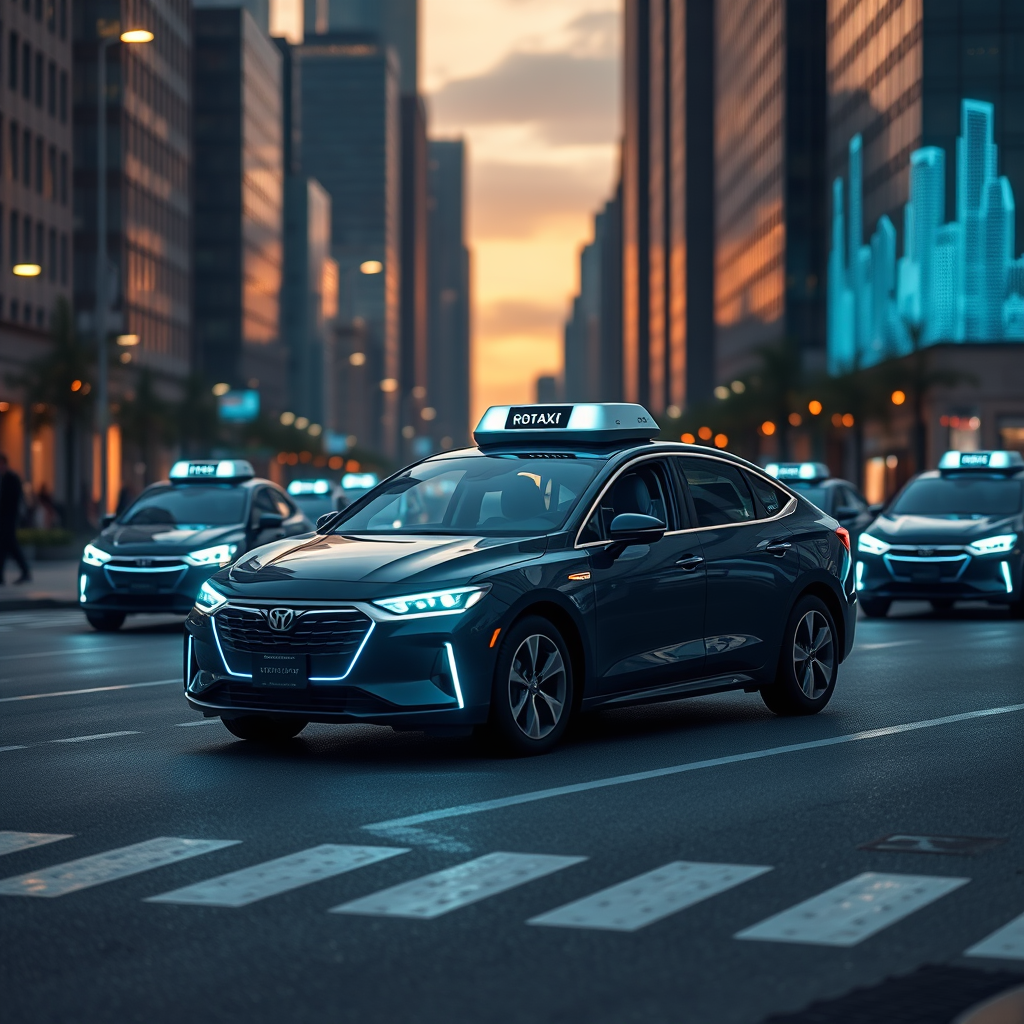
Introduction
DeepRoute.ai, a trailblazer in autonomous driving, has announced a bold new chapter: the launch of robotaxi services that will run on consumer‑grade production vehicles by the end of 2025. This move signals a decisive shift from laboratory prototypes and limited‑fleet pilots toward a scalable, commercially viable model that can be deployed in everyday cars. By leveraging its proprietary production vehicle platform, DeepRoute.ai aims to lower the cost barrier for autonomous mobility, democratize access to self‑driving technology, and accelerate the transition from niche to mainstream. The company’s announcement comes at a time when the autonomous vehicle industry is grappling with questions of safety, regulatory approval, and consumer trust. DeepRoute.ai’s strategy to use consumer vehicles as the backbone of its robotaxi fleet offers a practical solution that could reshape the way we think about on‑demand transportation.
The promise of robotaxis is not new; several high‑profile companies have explored the concept, yet few have successfully bridged the gap between cutting‑edge research and mass deployment. DeepRoute.ai’s approach—building a robust, production‑ready platform that can be installed on mass‑produced cars—addresses a key pain point: the high cost and complexity of equipping each vehicle with a bespoke autonomous stack. By standardizing the hardware and software across a fleet of consumer cars, the company can achieve economies of scale, streamline maintenance, and simplify regulatory compliance. The result is a business model that is both technologically sound and financially sustainable.
The Vision Behind Consumer‑Vehicle Robotaxis
DeepRoute.ai’s vision is rooted in the belief that autonomous mobility should be as ubiquitous as the cars themselves. Rather than relying on specialized, purpose‑built vehicles, the company envisions a future where any car that meets certain safety and connectivity criteria can become a robotaxi with a few modular upgrades. This democratization of autonomous technology has profound implications for urban mobility, reducing the need for private car ownership, and easing congestion in densely populated areas.
At the heart of this vision is a modular hardware suite that can be retrofitted onto existing production models. The suite includes high‑precision LiDAR sensors, advanced cameras, and a suite of processors capable of real‑time perception and decision making. Coupled with DeepRoute.ai’s proprietary software, which integrates sensor fusion, mapping, and path planning, the platform can deliver Level 4 autonomy in a wide range of driving scenarios. By focusing on consumer vehicles, the company also taps into a vast supply chain, enabling rapid scaling and reducing the capital expenditure required for fleet acquisition.
Technology Stack and Production Platform
DeepRoute.ai’s technology stack is built on a foundation of open‑source and commercial components, carefully curated to meet the stringent safety requirements of autonomous driving. The perception layer relies on a fusion of LiDAR, radar, and camera data, processed through deep neural networks that have been trained on millions of hours of driving data. These networks are optimized for low‑latency inference, ensuring that the vehicle can react to dynamic road conditions in real time.
The planning and control modules are equally sophisticated. Using high‑definition maps and real‑time sensor input, the system generates safe, comfortable trajectories that respect traffic rules and passenger comfort. The control layer translates these trajectories into precise actuator commands, ensuring smooth acceleration, braking, and steering. Importantly, the entire stack is designed for redundancy; critical components are duplicated, and fail‑safe modes are in place to guarantee safe operation even in the event of a hardware or software fault.
To support large‑scale deployment, DeepRoute.ai has also developed a fleet‑management platform that handles everything from vehicle health monitoring to dynamic routing. The platform collects telemetry from each car, performs predictive maintenance, and optimizes routing based on real‑time traffic data. This level of orchestration is essential for a robotaxi service, where reliability and efficiency directly impact customer satisfaction and profitability.
Business Implications and Market Strategy
Launching robotaxi operations on consumer vehicles offers a compelling business proposition. First, the cost of each vehicle is dramatically lower than that of a purpose‑built autonomous car, reducing the capital outlay required to build a fleet. Second, the use of consumer vehicles means that the company can tap into existing manufacturing and supply chains, allowing for rapid scaling and lower logistical overhead.
From a revenue perspective, the robotaxi model aligns with the growing demand for on‑demand mobility solutions. By offering a subscription or pay‑per‑ride model, DeepRoute.ai can generate recurring revenue streams while maintaining flexibility in fleet size. Moreover, the data collected from millions of miles of autonomous driving can be monetized or used to improve the platform, creating a virtuous cycle of innovation and profitability.
Strategically, DeepRoute.ai is positioning itself to partner with city governments, ride‑share platforms, and automotive OEMs. These collaborations can provide access to critical infrastructure, regulatory support, and a ready customer base. By demonstrating the feasibility of consumer‑vehicle robotaxis in pilot programs, the company can build trust with regulators and the public, paving the way for broader adoption.
Challenges and Regulatory Landscape
Despite the clear advantages, the path to mass deployment is fraught with challenges. Safety remains the paramount concern; any incident involving a robotaxi can erode public trust and trigger regulatory backlash. DeepRoute.ai must therefore invest heavily in rigorous testing, simulation, and real‑world validation to meet the safety standards set by agencies such as the National Highway Traffic Safety Administration (NHTSA) and the European Union’s General Safety Regulation.
Regulatory approval is another hurdle. Autonomous vehicle regulations vary widely across jurisdictions, and many regions still lack clear guidelines for Level 4 operations. DeepRoute.ai will need to engage with policymakers, contribute to the development of safety standards, and demonstrate compliance through transparent reporting and third‑party audits.
Operational challenges also loom large. Managing a fleet of consumer vehicles requires robust maintenance protocols, rapid response to software updates, and efficient handling of incidents. The company’s fleet‑management platform must be resilient, scalable, and capable of integrating with city traffic management systems to ensure smooth operation in complex urban environments.
Future Outlook and Impact on Mobility
If DeepRoute.ai succeeds in launching a consumer‑vehicle robotaxi service by 2025, the ripple effects could be transformative. The model would validate the feasibility of scaling autonomous mobility using existing production cars, potentially lowering the cost of entry for other players in the market. It could also accelerate the shift toward shared mobility, reducing the number of privately owned vehicles on the road and easing congestion.
Beyond the transportation sector, the data generated by millions of autonomous miles could spur advances in AI, mapping, and sensor technology. The insights gained from real‑world driving could feed back into the development of safer, more efficient autonomous systems, creating a positive feedback loop that benefits society at large.
In the longer term, the success of consumer‑vehicle robotaxis could pave the way for a new era of mobility where the distinction between private and shared vehicles blurs. As autonomous technology matures, we may see a future where any car can seamlessly transition between personal use and on‑demand service, unlocking unprecedented flexibility and convenience.
Conclusion
DeepRoute.ai’s announcement to launch robotaxi operations on consumer vehicles by the end of 2025 marks a pivotal moment in the autonomous driving industry. By marrying cutting‑edge perception, planning, and control algorithms with a scalable, production‑ready hardware platform, the company is poised to bring Level 4 autonomy to everyday cars. This strategy not only lowers the cost barrier for autonomous mobility but also aligns with the growing demand for shared, on‑demand transportation solutions.
The journey ahead will be challenging, with safety, regulatory, and operational hurdles to overcome. Yet the potential rewards—reduced congestion, lower emissions, and a more accessible mobility ecosystem—are compelling. If DeepRoute.ai can navigate these challenges successfully, it could set a new standard for how autonomous vehicles are deployed, bringing us closer to a future where self‑driving cars are as common as the vehicles we already own.
Call to Action
Are you excited about the prospect of autonomous cars becoming part of everyday life? Join the conversation by sharing your thoughts on how consumer‑vehicle robotaxis could reshape urban mobility. If you’re a developer, investor, or policy maker, consider how you can contribute to this emerging field—whether by collaborating on technology, funding pilot projects, or shaping regulations. Stay informed, stay engaged, and help drive the future of transportation forward.

